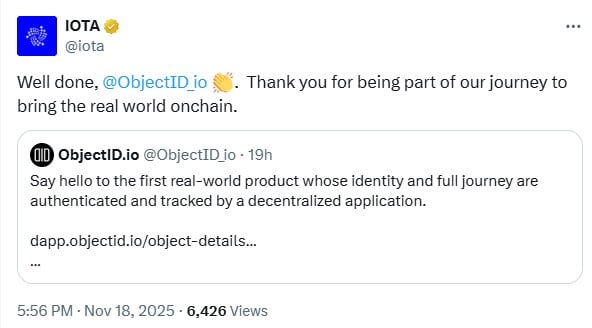IOTA Advances Real-World Adoption as ObjectID Launches Onchain-Verified Product
- ObjectID introduces a new on-chain verified product that users can explore by scanning the QR for the Lizard Medical board, expanding IOTA’s real-world application.
- IOTA and ObjectID are taking blockchain real-world adoption to new levels, showcasing ecosystem momentum.
IOTA, a decentralized blockchain infrastructure, is moving on with its focus on real-world adoption as ObjectID Launches Onchain-Verified Product. IOTA also acknowledged ObjectID for being part of its journey to bring the real world on-chain.
ObjectID Debut Onchain-Verified Product
In an X post, ObjectID announced the launch of its decentralized application (dApp), tracking its first physical product on the IOTA network.
In the post, ObjectID shared the linked dApp page that displays details for a specific ObjectID, a unique cryptographic hash, produced by Lizard Medical Italy.
Responding to the post, IOTA acknowledged the achievement as a practical step forward that reflects its broader mission in real-world adoption.

The full journey of the new product encompasses its creation, ownership transfers, and updates. These are recorded immutably on IOTA’s ledger using verifiable credentials and smart contracts written in the Move language.
Users scan a QR code on the product to access the dApp, which verifies the creator’s Decentralized Identifier (DID), a W3C-standard digital identity tied to the lizardmed.it domain. This proves the issuer controls the domain, preventing forgery. Hence, no one can fake an ID without domain access.
In essence, ObjectID is turning a physical object into a smart asset with a verifiable blockchain passport, accessible via simple QR scans.
ObjectID Strengthens Ties With IOTA
ObjectID is a blockchain-based platform that offers a suite of solutions tailored to meet diverse industry needs, ensuring traceability, authenticity, and product security.
It focuses on assigning tamper-proof digital identities to physical products, even in complex, distributed production processes. Key features include blockchain-backed traceability, controlled updates, end-to-end visibility, and historical data archiving.
As highlighted in our previous article, ObjectID is built on the IOTA blockchain, leveraging its feeless, scalable, and energy-efficient Tangle technology. This allows for zero-cost transactions, real-time updates, and integration with IoT devices without the need for wallets or gas fees.
Also, ObjectID filed a patent with the European Patent Office for its decentralized product identity system built on the IOTA mainnet. The platform aimed to give manufacturers a simple way to assign each physical good a unique digital twin and to record every modification on an immutable ledger.
Meanwhile, the IoT industry is eyeing explosive growth, with an estimated 25 billion connected devices by 2026 and 40 billion by 2030.
ObjectID’s ability to integrate seamlessly with physical objects positions it at the forefront of this revolution. Thus, the launch of its on-chain verified product signifies not just innovation but also a tangible leap toward real-world blockchain applications.
Likewise, IOTA continues to expand its ecosystem, accelerating the shift from centralized databases to a decentralized, trustworthy digital economy. As outlined in our recent blog post, IOTA has introduced a new trust framework design that supports data verification and asset exchange across industries.
Disclaimer: The content of this article solely reflects the author's opinion and does not represent the platform in any capacity. This article is not intended to serve as a reference for making investment decisions.
You may also like
Ethereum News Today: Ethereum Faces $2,800 Test—Will It Surge to $3,000 or Retreat to $2,300?
- Ethereum tests $2,800 resistance, key threshold for November, with potential to rebound toward $3,000 if breakout succeeds. - Recent $55.7M inflow into ETH ETFs, led by Fidelity’s FBETH, signals cautious institutional interest after nine-day outflow streak. - Technical indicators show improved momentum with RSI rebound and MACD stabilization, but $2,800 remains critical for further gains. - Derivatives data and Coinbase’s ETH-backed lending expansion hint at conditional recovery, though liquidation risks

Ethereum Updates: Centralized DNS Compromise Highlights DeFi Weaknesses as Aerodrome Suffers $1 Million Loss
- Aerodrome Finance suffered a DNS hijacking attack on Nov 22, 2025, redirecting users to phishing sites that siphoned over $1M in assets through deceptive transaction approvals. - Attackers exploited vulnerabilities in centralized domain registrar Box Domains, forcing users to approve unlimited access to NFTs and stablecoins via two-stage signature requests. - The protocol shut down compromised domains, urged ENS-based access, and revoked recent token approvals, marking its second major front-end breach i

Trump and Mamdani’s Bet on Affordability: Uniting Opposing Ideologies
- Trump and Mamdani's Nov. 21 meeting highlights clashing ideologies on affordability and governance, with New York's $1.286T economy at stake. - Both leaders share focus on cost-of-living crises but differ sharply on solutions, with Trump threatening federal funding cuts and Mamdani advocating rent freezes. - Experts see the dialogue as critical for redefining strained city-federal relations, emphasizing urban centers' role as economic engines. - Mamdani's corporate tax proposals clash with Trump's deregu

Bitcoin News Update: Navigating Crypto’s Balancing Act to Steer Clear of 2018’s Downturn as Global Economic Conditions Evolve
- Crypto markets avoid 2018-style collapse as macro-driven cycles and reduced speculation prolong volatility, per Lyn Alden. - Fed policy uncertainty and leveraged ETF launches highlight risks and innovations amid $2.2B crypto outflows and $914M liquidations. - MSTR's BTC gains and Gunden's $1.3B sell-off reflect divergent investor strategies, while Munari's Solana project targets long-term adoption. - Analysts split between 65-70% Bitcoin retracement forecasts and prolonged cycles driven by institutional

